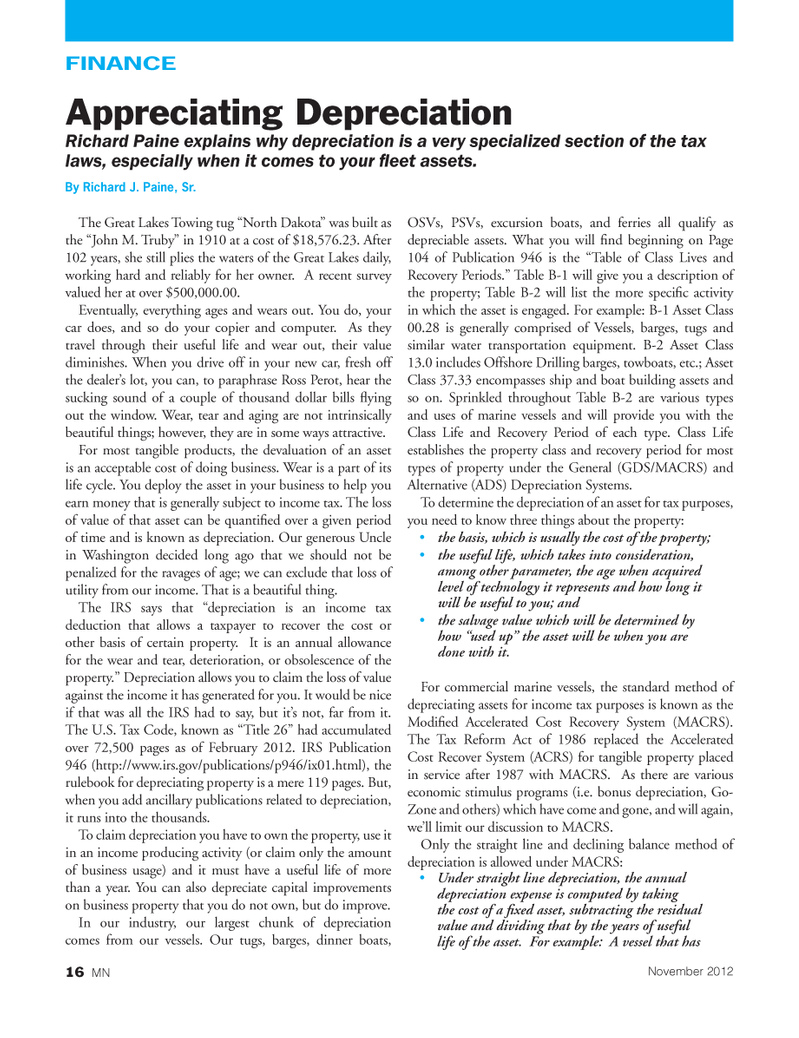
Page 16: of Marine News Magazine (November 2012)
Workboat Annual
Read this page in Pdf, Flash or Html5 edition of November 2012 Marine News Magazine
The Great Lakes Towing tug ?North Dakota? was built as the ?John M. Truby? in 1910 at a cost of $18,576.23. After 102 years, she still plies the waters of the Great Lakes daily, working hard and reliably for her owner. A recent survey valued her at over $500,000.00. Eventually, everything ages and wears out. You do, your car does, and so do your copier and computer. As they travel through their useful life and wear out, their value diminishes. When you drive off in your new car, fresh off the dealer?s lot, you can, to paraphrase Ross Perot, hear the sucking sound of a couple of thousand dollar bills ying out the window. Wear, tear and aging are not intrinsically beautiful things; however, they are in some ways attractive. For most tangible products, the devaluation of an asset is an acceptable cost of doing business. Wear is a part of its life cycle. You deploy the asset in your business to help you earn money that is generally subject to income tax. The loss of value of that asset can be quanti ed over a given period of time and is known as depreciation. Our generous Uncle in Washington decided long ago that we should not be penalized for the ravages of age; we can exclude that loss of utility from our income. That is a beautiful thing. The IRS says that ?depreciation is an income tax deduction that allows a taxpayer to recover the cost or other basis of certain property. It is an annual allowance for the wear and tear, deterioration, or obsolescence of the property.? Depreciation allows you to claim the loss of value against the income it has generated for you. It would be nice if that was all the IRS had to say, but it?s not, far from it. The U.S. Tax Code, known as ?Title 26? had accumulated over 72,500 pages as of February 2012. IRS Publication 946 (http://www.irs.gov/publications/p946/ix01.html), the rulebook for depreciating property is a mere 119 pages. But, when you add ancillary publications related to depreciation, it runs into the thousands. To claim depreciation you have to own the property, use it in an income producing activity (or claim only the amount of business usage) and it must have a useful life of more than a year. You can also depreciate capital improvements on business property that you do not own, but do improve. In our industry, our largest chunk of depreciation comes from our vessels. Our tugs, barges, dinner boats, OSVs, PSVs, excursion boats, and ferries all qualify as depreciable assets. What you will nd beginning on Page 104 of Publication 946 is the ?Table of Class Lives and Recovery Periods.? Table B-1 will give you a description of the property; Table B-2 will list the more speci c activity in which the asset is engaged. For example: B-1 Asset Class 00.28 is generally comprised of Vessels, barges, tugs and similar water transportation equipment. B-2 Asset Class 13.0 includes Offshore Drilling barges, towboats, etc.; Asset Class 37.33 encompasses ship and boat building assets and so on. Sprinkled throughout Table B-2 are various types and uses of marine vessels and will provide you with the Class Life and Recovery Period of each type. Class Life establishes the property class and recovery period for most types of property under the General (GDS/MACRS) and Alternative (ADS) Depreciation Systems. To determine the depreciation of an asset for tax purposes, you need to know three things about the property: the basis, which is usually the cost of the property; the useful life, which takes into consideration, among other parameter, the age when acquired level of technology it represents and how long it will be useful to you; and the salvage value which will be determined by how ?used up? the asset will be when you are done with it. For commercial marine vessels, the standard method of depreciating assets for income tax purposes is known as the Modi ed Accelerated Cost Recovery System (MACRS). The Tax Reform Act of 1986 replaced the Accelerated Cost Recover System (ACRS) for tangible property placed in service after 1987 with MACRS. As there are various economic stimulus programs (i.e. bonus depreciation, Go- Zone and others) which have come and gone, and will again, we?ll limit our discussion to MACRS. Only the straight line and declining balance method of depreciation is allowed under MACRS: Under straight line depreciation, the annual depreciation expense is computed by taking the cost of a xed asset, subtracting the residual value and dividing that by the years of useful life of the asset. For example: A vessel that has FINANCEAppreciating Depreciation Richard Paine explains why depreciation is a very specialized section of the tax laws, especially when it comes to your ß eet assets. By Richard J. Paine, Sr. 16 MNNovember 2012MNNov2012 Layout 1-17.indd 16MNNov2012 Layout 1-17.indd 1610/26/2012 11:48:02 AM10/26/2012 11:48:02 AM

 15
15

 17
17
